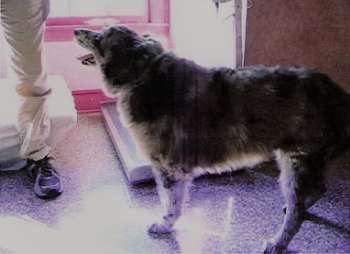- By Betty Hegarty
- Around Town
 Print
Print 

Aussie finally stands on her own following an early acupuncture treatments
Dr. Murley started to treat Aussie on September 19th, and the December 5th visit was her 11th acupuncture visit. It was the first time that two weeks had passed since a prior visit. Dr. Murley stressed the fact that, in the case of Aussie, her owners, Mr. and Mrs. Davidson, were a very big part of the team working to help Aussie get better. After the surgery, although Aussie could not walk, the Davidsons would take her swimming daily. Initially, she was only able to swim a short distance. Over time, the distance increased. They would use a sling to help Aussie remain upright when she had to go outside.
Even after Aussie could swim, she still couldn’t stand upright on a land surface. The Davidsons installed a ramp which enabled Aussie to go outdoors more easily. They made adjustments to the hard, smooth surfaces of the floors in their home since Aussie first was only able to walk on rough surfaces when she did begin walking again. Since she has been treated with acupuncture, Aussie has progressed to the point where a sling is no longer needed. She can walk and even run on her own. Following her treatment, I watched as her owners gave her belly rubs. Her movements seemed entirely comfortable, even when she was rolling over for the belly rub. I also watched her walk. She walked fine. Her gait was a bit lame, but the Davidsons advised me that was due to the hip injury, which caused her to walk with her left leg somewhat protruding.
Roseanna Davidson also mentioned that, following the disc surgery, Aussie’s elbows had been starting to weaken. The acupuncture treatment specific to the elbows has even helped take the stress off of the elbows and to keep Aussie pain free. Mrs. Davidson also mentioned that Aussie no longer has to be on a strong dose of pain medicine, but is only on ½ dose of her prescribed medicine daily.
As time goes on, it is hoped that Aussie will be able to lengthen her time between acupuncture visits, and may even be able discontinue them altogether. Dr. Murley advised me that many animals respond well to acupuncture and only have to be treated several times – every animal and every condition which brought the animal to acupuncture is different. It is possible that Aussie will also undergo traditional physical therapy in the future, utilizing the animal underwater treadmill, so she is able to exercise during a time of year when it is difficult to go outside and run and play due to the cold and stormy weather.
I asked Dr. Murley what other diseases or conditions are commonly treated with acupuncture. She said arthritis and mobility issues are most commonly treated. However, she also advised that many animals are treated for allergies, skin problems and many other conditions. She said she had treated an animal for chronic ear infections. Not only have the ear infections almost been eliminated, but the animal has shown signs of being much happier, relaxed and confident.
To summarize, acupuncture has an impact on the whole system – on the mental and emotional as well as on the physical system. There are virtually no side effects, as is the case with many medications. Nothing is being cut away – acupuncture is mostly non-invasive. Acupuncture can be used on different types of animals, and also on humans.
We hope the information we obtained from Dr. Murley will one day help your pet benefit from this method of treatment. If you would like to find out more about acupuncture for your pet, you may contact Colonial Veterinary Hospital for more information or any veterinarian, who would be able to give you a referral to Colonial if it is believed that an acupuncture consult and subsequent treatment would be helpful to your pet.
In next week’s column, since so many pet owners give their pets Christmas presents, we will talk about what types of toys and treats are safe for pets.
----
v1i21



